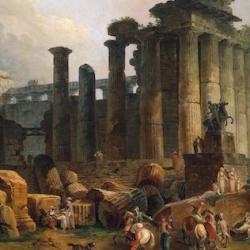John and Gloria Ben-Daniel argue in their The Apocalypse in the Light of the Temple that the temple serves as the “organizing principle” of John’s Apocalypse (4). The background of the book, then, is not Roman persecution of the church but “the destruction of the second Temple in AD 70 and the subsequent reformation of Judaism at Jamnia.” Revelation is “the divine response to the destruction of Jerusalem” (4, fn. 3).
They offer some initial observations to make this claim plausible. Revelation is full of references to the “parts, furnishings, objects and actions” of the temple. The word naos occurs 16 times; outer courts and altars and lampstands, harps,m trumpets, and libation bowls recur. Worship is one of the central activities in the book (4-5).
This leads them, for instance, to understand the reference to Jesus as “one like a son of man” as a reference to Aaron, who stands among the lampstands carrying out His priestly tasks: “the figure of ‘one like a son of man’ corresponds to Aaron, the high priest; the sword projecting from his mouth (Ap 1,16) is the instrument with which he trims the lampstands, and the Spirit that speaks through him (Ap 2,7.11.17.29; 3,6.13.22) is the heavenly oil. By trimming and refuelling the lampstands, which represent the local churches on earth, he keeps them firmly united to their flames, or angels, in heaven. Not only does this vision of the trimming and refuelling of the lamps accurately represent the reproof and encouragement transmitted to the churches in the subsequent letters dictated to John (Ap chs.2–3), but it also introduces the liturgical character of this vision of God’s Sanctuary” (23).
The focus on the temple guides their large-scale conclusions about the theology and structure of Revelation. In Revelation as nowhere else in the New Testament Jesus “reveals himself fulfilling every type of sacrifice” and the entire “sacrificial cult of the Jews,” which is thereby “completely fulfilled and is now obsolete” (74). They argue, further, that the liturgical structure of the book indicates that the events of the book on sequential: “the liturgy revealed in the Apocalypse follows a very precise chronological order. Since the events described in the visions of the Apocalypse are determined by this order, it follows that these events also succeed one another in a definite temporal order” (75).
This is a rich, detailed, rewarding, and provocative book.















